Progress report for GNC23-370
Project Information
Investigating the effect of a commonly used apiculture antibiotic on honeybee colony thermoregulation and health
The overuse of antibiotics in agriculture has led to a public health crisis in increased antibiotic resistance and toxicity in our managed livestock and agricultural land. Thus, research into how antibiotics impact fundamental aspects of animal husbandry is essential to address this crisis. During the management of Western honeybee (Apis mellifera) populations for the pollination of crops and honey production, beekeepers often use antibiotics approved for livestock to prophylactically prevent or treat diseases in their colonies. Recent studies have shown that antibiotic treatment may be a detriment to honeybee livelihood and could be contributing to the huge loss in colonies annually. However, few studies have investigated the effect of antibiotics on honeybee behavior, which is critical to consider because honeybees are highly social animals that depend on tight coordination of behaviors to maintain optimum colony function. Any disruption of these behaviors can potentially contribute to colony failure. An essential behavior that honeybees perform is fanning, a thermoregulatory behavior performed at the entrance of the colony to keep internal temperatures at 95°F for proper brood development. My previous data, obtained in a laboratory setting, demonstrates that fanners treated with antibiotics are less likely to fan and are unable to quickly respond to heat stress. Therefore, the central hypothesis for my NCR-SARE project is that prophylactic colony-wide antibiotic treatment will disrupt proper thermoregulation. To test this hypothesis, I will work with a commercial Wisconsin beekeeper and monitor the temperatures of a subset of his colonies before and after antibiotic treatment using temperature sensors. I will couple this temperature data with behavioral observations of fanning at the entrance of the colony and measurements of colony health such as colony weight, gut microbiome composition, mite counts, and bee mortality, as it is possible that colony temperatures are maintained at the cost of colony health. Project outcomes are 1) generating key data to be presented at national scientific conferences and published in both science and beekeeping journals and 2) educate beekeepers on best practices regarding the usage of antibiotics in their hives. We will evaluate the success of my project through rigorous data analysis and measuring overall engagement with my planned talks and surveys. If funded, this research will be the first NCR-SARE graduate student research project to investigate the effects of prophylactic antibiotics on honeybee behavior and health.
Because of research exposing the effects of antibiotic use on honeybee health, the Food and Drug Administration’s (FDA) Center for Veterinary Medicine recently passed the Veterinary Feed Directive (VFD) initiative, which requires beekeepers to obtain a veterinary prescription to purchase antibiotics. However, many beekeepers have expressed concern that this initiative will lead to diseases like American Foulbrood to resurge and cause increased colony loss. Thus, many beekeepers appear to be unaware of the adverse effects antibiotics have on honeybee livelihood and may not understand the need for such an initiative. Therefore, the following outcomes are expected on completion of my project:
Learning outcomes (through talks, presentations, and course curriculum):
- Researchers will understand the effect of antibiotic on temperature regulation of hives
- Beekeepers will understand the risks of prophylactic antibiotic use for colony health and behavior
Action outcomes:
- Beekeepers will stop using antibiotics except when treating active diseases
- Reduced financial strain in replacing their colonies annually
- Reduced contributions to antibiotic pollution in the environment
Cooperators
- (Researcher)
Research
Throughout this progress report, we use terminology that is common in beekeeping and honeybee research that may not be clear to anyone outside the field. Please see the table below for the definition of these terms. We hope this clears up any confusion during the review of this report.
|
Terminology |
Broad Definition |
|
Deep |
A wooden box that contains wooden frames where bees can build their comb, store their resources, and rear their young. Single deep colonies have 1 of these boxes, while double deep colonies have 2, etc. Typically, beekeepers keep their colonies to 2-3 deeps. |
|
Frame |
A wooden support that represents a single “slice” of a colony. Bees build their comb onto these supports. There were 8 frames per deep in our study. |
|
Super |
A wooden box that is commonly half the size of a deep that beekeepers place on top of colonies during nectar flows. These boxes act as extra storage reserves for bees to store their excess honey and are harvested by beekeepers at the end of the nectar flow. |
|
Porch |
Another term for the entrance of the colony. The porch is where honeybee foragers will come and go as needed, and where fanners and guards can be seen performing their jobs. |
|
Cells |
Refers to the holes within the honeybee comb where resources are stored, and honeybee offspring are reared. |
|
Brood |
Another broad word for offspring or young. A queen will lay an egg inside of a cell. These eggs hatch into larvae and are reared by worker bees inside of the comb. |
|
Uncapped brood |
Honeybee offspring that are in the earliest stages of development. During this time, because workers are directly feeding and caring for brood, their cells are kept open for the workers to access them. |
|
Capped brood |
Honeybee offspring that are in the final stages of development. Cells are covered in a wax cap covering to protect the young bees as they undergo their final metamorphosis into adult bees. |
On May 1st, 24 honeybee (Apis mellifera) colonies from Concord Farms were installed at a field site located in Oconomowoc, Wisconsin (43° 6' 24.1662", -88° 37' 18.8904"). Colonies were kept on 6 pallets with 4 colonies per pallet (See Photo 1). Colonies were originally set up as one deep with 8 frames, and all colonies were given a second deep on May 16th for the rest of the study. On May 17th, all colonies were assigned a numbered tag, and the lids of colonies designated for antibiotic treatment were painted yellow and marked by bright orange duct tape. Treatment alternated by pallet: whole pallets consisted of colonies that received the same treatment to minimize potential contamination between treatment groups. On May 24th, we installed BroodMinder-T2SM internal hive monitors in the center of 20 of these colonies in-between deeps to continuously collect internal hive temperature data.
Prophylactic antibiotic treatment was given in two rounds as directed by Food and Drug Administration (FDA) guidelines, once at the beginning of the season and again near the end of the season. On June 3rd, all colonies received their first round of treatment, where half of the colonies (3 pallets) received 1oz of powdered sugar (treatment group referred as “sugar”) and the other half received 1oz of powdered sugar and 200mg of oxytetracycline hydrochloride (Oxytet® Soluble), which was procured from a local veterinarian (treatment group referred as “antibiotic). 200mg per colony is the approved oxytetracycline dosage by the FDA. Treatment was dusted at the edges of the frames of the top deep of all colonies as required by FDA guidelines (See Photo 2). This regimen was repeated twice with 5-day intervals in-between, for a total of 3 doses across the month of June, and this treatment course was repeated in September.
Throughout the summer, we took several measurements to assess colony health. First, to assess colonies’ abilities to thermoregulate themselves, at least three times per week, we counted the number of fanners present on the entrance of all colonies. Fanners are a specialized worker honeybee whose job is to thermoregulate the colony. Although fanners fan throughout the colony, they are easily identifiable on the porch of the colony, as they stand still with their abdomens angled downward and rapidly flap their wings to generate airflow. Thermal fanning is distinct from Nasanov fanning (fanning that acts as a homing signal) because bees do not expose their Nasanov glands and have their abdomens curved downward when they thermally fan. We noted where fanners were standing on the porch. We measured the ambient temperature of the field site and surface temperature of the porch using a temperature gun (Flukeâ 568 Infrared Thermometer). We also used a lux meter (EXTECH 401025: Light Meter) to measure light intensity on the porch, as heat and light are interlinked, and we were interested in the role light may play in triggering fanning behavior. We performed these fanning observations in the afternoon when temperatures were at their peak and recorded the time when we made each of the observations. During these fanning observations, we also downloaded any new data collected by all Broodminder-T2SM monitors inside the colony. See this document (File1ObsFannerDataSheets) for the data sheets we used to collect this data.
Twice per month, all colonies were subjected to a full hive inspection, where colonies were weighed and opened, and every frame of the colony was thoroughly inspected, starting from the bottom deep (See Photo 3). We estimated the proportion of the frame that was filled with honey, pollen, uncapped brood, and capped brood. We also estimated a proportion of the total brood that was drone brood, which was identifiable by the large size of drone comb compared to regular worker brood comb. Additionally, we estimated the proportion of worker bees that were on the frame, separate from the resources that were stored on the frame itself, as an approximation of worker population in the colony. After inspecting a deep, inspectors randomly collected 5-10 workers into 15mL falcon tubes from the deep for later gut microbiome analysis. These samples were stored once back in the lab at -80°C for later processing. These collections occurred three times in June, once in July, three times in September, and once in October. See this document (File2HiveInspectionTemplate) for the data sheets we used to collect this data.
We allowed Ryan Stern of Concord Farms to manage his colonies as necessary to maintain as field realistic settings as we could. Ryan noted when he managed the colonies, and we will control for these management moments in our final analysis. All data was written on data sheets (See Files 1 & 2) that was then transcribed into Excel that was transferred to Marquette University’s cloud-based Microsoft SharePoint OneDrive service for long-term storage. All data analysis and visualization were performed in the program R (v. 4.3.2).
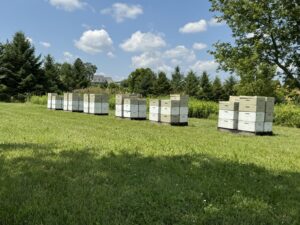
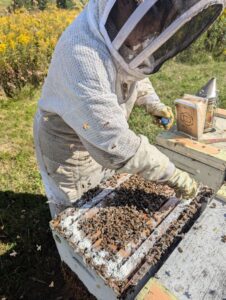
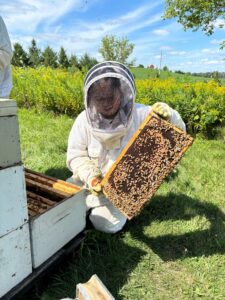
Based on our methodology detailed above, we measured several metrics of colony composition and health (weighing colonies, inspecting them inside and out, collecting continuous colony temperature data, and observing number of fanners present at the entrance of colonies). Contrary to our predictions, preliminary results suggest that prophylactic oxytetracycline treatment may be beneficial to long term honeybee colony health. First, antibiotic treated colonies had on average significantly higher proportions of worker bees, brood, and pollen on their frames (See Figure 1; Wilcoxon rank sum tests, p-value < 0.05). Further, antibiotic treated colonies produced more honey: the average end weight of supers from these colonies at time of harvest was 45.86lbs compared to 34.03lbs in the other treatment group (See Figure 2A; Wilcoxon rank sum tests, p value = 0.007828). These differences appeared to not be driven by differences in colony weight, as all colonies gained the same amount of weight over the course of the summer (See Figure 2B; Wilcoxon rank sum test, W = 5069, p-value = 0.4413). There may be some seasonal effects on the trajectory of how these colonies gained weight, as non-treated colonies appeared to have a slower and gradual increase in weight before taking off later in the season and catching up with the treated colonies (See Figure 2A).
Antibiotic treatment had little effect on the number of fanners colonies had on their porches (See Figure 3). We did observe more fanners on porches as ambient temperatures increased for all colonies (See Figure 3). However, at an ambient temperature of around 45°C, the number of fanners observed dropped, indicating that there may be a temperature threshold at which colonies will no longer invest energy into fanning as a thermoregulatory strategy. We will analyze BroodMinder data to investigate how well colonies maintain internal colony temperatures as a metric of efficiency, as it is possible that although colonies put out the same number of fanners, the efficiency of those fanners may be different between treatment.
Altogether, these data do not support this project’s original hypothesis and predictions that antibiotic treatment is detrimental to honeybee colonies and have exciting implications for the next steps. Instead, data suggests that antibiotic treated colonies were protected from disease and could therefore produce a larger honeybee workforce and collect more resources to produce more honey. During hive inspections, we did screen for whether we saw evidence for disease on the frames, so we will properly test this hypothesis. Future analysis will focus on characterizing any changes to the honeybee gut microbiome and the prevalence of antibiotic resistance genes to assess risk of the spread of antibiotics in agricultural environments.
Educational & Outreach Activities
Participation summary:
These data have been presented to the local scientific community several times. First, Justine has presented preliminary results as part of her annual graduate student seminar to Marquette University's Department of Biological Sciences (2025GradSeminar). Additionally, she competed in Marquette University Graduate School Student Poster Competition using some of the data gathered from this project (Nguyen2025GradPosterComp). Furthermore, these data have informed the design of several outreach activities in the local Milwaukee community. For example, Justine has designed a waggle dance game where students must work together to create "dances" to communicate the location of certain flowers to their teammates without verbal speech. This game has been used to teach students what happens when honeybee communication could be disrupted when bees are sick.
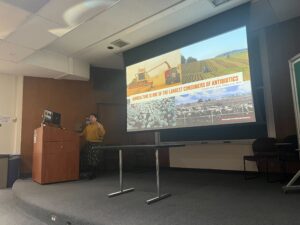
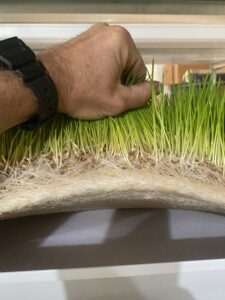
Once full analysis is complete, these data will be written up and submitted to be published as a scientific article in a scientific journal such as Frontiers in Bee Science or Journal of Apicultural Research. These data will also be presented at national science conferences like Entomology and at beekeeping conferences such as the American Beekeeping Federation conference. Additionally, these data will be used to design upcoming workshops this year for local Wisconsin beekeepers to teach them the benefits of controlled antibiotic use and the dangers of its overuse.
Project Outcomes
Previous literature suggests that prophylactic antibiotic treatment is an overall detriment to individual honeybee health, as it increases mortality, disease susceptibility, and gut dysbiosis. However, because prophylactic antibiotic treatment is given at the colony level, it is difficult to replicate how much antibiotics individual bees consume in the lab. Thus, the concentration of antibiotics given for lab-based studies may not be necessarily relevant at the colony level, where the consumption of antibiotics per individual may be sparse. Furthermore, in response to rising concerns about the spread of antibiotic resistance and its detriments on honeybee colonies, many beekeepers have adopted an all-or-nothing response, where they either continue to misuse antibiotics in their colony or stop using them altogether. As a result, many beekeepers appear to be unaware of the adverse and beneficial effects antibiotics have on honeybee livelihood.
This project will contribute to future agricultural sustainability by 1) providing an accurate assessment of FDA approved dosages of antibiotic use on honeybee colonies and 2) educating beekeepers on the benefits of appropriate antibiotic usage and dangers to its misuse. This project will improve the economic viability of beekeeping by reducing number of colonies lost to disease and potentially increasing overall honey production. It may also reduce unnecessary antibiotic misuse when beekeepers are equipped with the knowledge gained from this project. This project will also potentially remove biases that are present within the beekeeping community surrounding the usage of “chemicals” like antibiotics in their colonies.
Before conducting this study, I expected prophylactic antibiotic treatment to have a negative effect on honeybee colonies based on the literature. I have a long history working with the consequences of anti-microbial resistance and antibiotic toxicity in the environment, so I was heavily biased towards antibiotics being bad for bees overall. However, after working with the colonies and analyzing part of my data, I now can appreciate how antibiotics, when used properly and in the recommended dosages, can be beneficial to colony health and success. I previously would have advocated for stopping the usage of antibiotics altogether, but now I understand that like much of biology, antibiotics can be a beneficial tool, so long as we do not abuse its usage. Realistic, sustainable agricultural change begins by fully understanding the nuanced effect that human activity has on our environment, and this project highlighted the importance of taking research into the field and testing it within relevant contexts.
Conducting this project has taught me much about field work, beekeeping, collaborating with the local community, and how honeybee colonies behave throughout the season. It also taught me about what beekeepers care about in terms of colony health and success, which has made a more well-rounded honeybee researcher and has positioned me well to educate the Wisconsin beekeeping community on this subject. This project has only bolstered my passion for applicable science that involves the community and is designed with the community in mind. I am excited to dive into the molecular part of this project to directly assess whether the prophylactic use increases prevalence of antibiotic resistance in the environment.